Using NASA, Japanese, and European X-ray satellites, a team of Japanese astronomers has discovered that our galaxy’s central black hole let loose a powerful flare 3 centuries ago.
The finding helps resolve a long-standing mystery: why is the Milky Way’s black hole so quiescent? The black hole, known as Sagittarius A* (pronounced “A-star”), is a certified monster, containing about 4 million times the mass of our Sun. Yet the energy radiated from its surroundings is billions of times weaker than the radiation emitted from central black holes in other galaxies.
“We have wondered why the Milky Way’s black hole appears to be a slumbering giant,” says team leader Tatsuya Inui of Kyoto University in Japan. “But now we realize that the black hole was far more active in the past. Perhaps it’s just resting after a major outburst.”
The new study, which will appear in the Publications of the Astronomical Society of Japan, combines results from Japan’s Suzaku and ASCA X-ray satellites, NASA’s Chandra X-ray Observatory, and the European Space Agency’s XMM-Newton X-ray Observatory.
The observations, collected between 1994 and 2005, revealed that clouds of gas near the central black hole brightened and faded quickly in X-ray light as they responded to X-ray pulses emanating from just outside the black hole. When gas spirals inward toward the black hole, it heats up to millions of degrees and emits X-rays. As more and more matter piles up near the black hole, the greater the X-ray output.
Amazingly, a region in Sagittarius B2 only 10 light-years across varied considerably in brightness in just 5 years. These brightenings are known as light echoes. By resolving the X-ray spectral line from iron, Suzaku’s observations were crucial for eliminating the possibility that subatomic particles caused the light echoes.
“By observing how this cloud lit up and faded over 10 years, we could trace back the black hole’s activity 300 years ago,” says team member Katsuji Koyama of Kyoto University. “The black hole was a million times brighter 3 centuries ago. It must have unleashed an incredibly powerful flare.”
This new study builds upon research by several groups who pioneered the light-echo technique. Last year, a team led by Michael Muno, who now works at the California Institute of Technology, used Chandra observations of X-ray light echoes to show that Sagittarius A* generated a powerful burst of X-rays about 50 years ago — about a dozen years before astronomers had satellites that could detect X-rays from outer space. “The outburst three centuries ago was 10 times brighter than the one we detected,” says Muno.
The galactic center is about 26,000 light-years from Earth, meaning we see events as they occurred 26,000 years ago. Astronomers still lack a detailed understanding of why Sagittarius A* varies so much in its activity. One possibility, says Koyama, is that a supernova a few centuries ago plowed up gas and swept it into the black hole, leading to a temporary feeding frenzy that awoke the black hole from its slumber and produced the giant flare.











